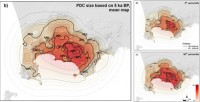Volcanic hazard assessement at Campi Flegrei caldera with uncertainty quantification
| 28 Gennaio 2016 | ore 11 | Andrea Bevilacqua – INGV e SNS PI | Sala seminari – INGV Sezione di Pisa
Abstract
Campi Flegrei is the most active caldera in Europe with more than 70 eruptions within the last 15 ka: the great majority of them have been explosive, variable in magnitude, intensity and vent location. Very high risks are associated with the occurrence of pyroclastic density currents (PDCs). Mapping of long-term PDC hazard in the area is a great challenge due to the unknown eruption time, scale and vent location of the next event as well as the complex dynamics of the flow over the caldera topography. This is additionally complicated by the remarkable epistemic uncertainty on the eruptive record, affecting the time of past events, the location of vents as well as the PDCs areal extent estimates.
The reported study includes three main parts, each one dedicated to a different aspect of the volcanic hazard probability assessment at Campi Flegrei caldera, with a particular attention to the uncertainty quantification. The parts correspond to the construction of: i) a map of probability for the location of the next eruptive vent, ii) a probability distribution for the size of the next PDC, and a map of probability for the PDC invasion hazard, iii) time-space probability model for the time of the next eruption, focused on the vent clustering.
In particular, Campi Flegrei volcano was assumed as a complex random system that had to be coped with incomplete and uncertain information. All the assessments were affected by a very large uncertainty and they could not be easily forecasted with a simple probability distribution. This raised the definition of a double probability space with two different probability frameworks: one expected to describe the physical variability of the system, the other assessing the epistemic uncertainty due to the imperfect knowledge available.
The research presented was accomplished during a three years long PhD project, and including the contribution and support of ideas of many colleagues inside the Institute or participating to the DPC-V1 and MEDSUV supersite projects.


